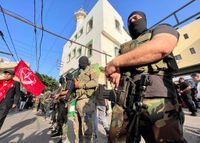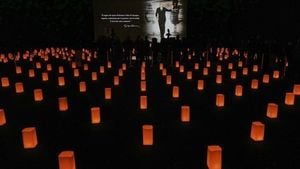On August 7 and 8, 2025, a series of Israeli airstrikes in Lebanon marked the deadliest escalation in weeks, killing high-ranking militant figures and a prominent journalist, and sending shockwaves through an already volatile region. Despite a ceasefire agreed upon in November 2024, these attacks underscore the fragility of peace along the Israel-Lebanon border and the deep divisions within Lebanese politics over how to respond.
The violence began on the afternoon of August 7, when an Israeli airstrike near the Masnaa border crossing in eastern Lebanon targeted a vehicle traveling toward Syria. According to the Popular Front for the Liberation of Palestine (PFLP), the strike killed Mohammed Wishah, a senior member of the group’s central committee and its top security official in Syria, along with his bodyguard, Mufid Hussein. The Israeli military quickly confirmed responsibility, stating that Wishah was actively engaged in coordinating operations with other militant groups and was advancing plans to carry out attacks against Israel. The army further asserted that Wishah had taken on his role in Syria after his predecessor was killed in a similar Israeli strike in Beirut in September 2024, as reported by The Times of Israel and AP.
Lebanon’s National News Agency reported that the airstrike killed six people and wounded ten others, though not all the victims were immediately identified. PFLP officials said Wishah had been in Lebanon for internal meetings and was on his way back to Syria when he was killed. Wishah’s political biography is notable: born in the Gaza Strip in 1954, he joined the PFLP in 1973 and spent five years in Israeli prisons early in his life. For decades, the leftist and secular PFLP has been the second-largest member of the Palestinian Liberation Organization, after Fatah, according to AP and The Times of Israel.
Tributes poured in from PFLP leaders and supporters. Senior PFLP official Marwan Abdel-Al mourned the loss of Wishah and Hussein, writing on social media, “We have lost two of the most loyal comrades who gave their precious souls to freedom.” The group’s statement and the outpouring of grief reflected the high esteem in which both men were held within the organization.
Less than 24 hours later, on the morning of August 8, another Israeli drone strike hit a vehicle on the Zahrani road in Lebanon’s Nabatieh district. This time, the victim was Mohammad Shehadeh, a journalist, photojournalist, and director of the Hawana Lebanon news website. The Lebanese Health Ministry confirmed the death, and the National News Agency reported that civil defense teams recovered Shehadeh’s body from the targeted car along the Sidon-Tyre coastal road. Initial reports described Shehadeh as a local media figure, but Hezbollah later claimed him as one of its own, with Israeli officials identifying him as chief of intelligence in Hezbollah’s elite Radwan force, as stated by Anadolu and Press TV.
The back-to-back attacks came amid ongoing Israeli operations in Lebanon, which have continued despite the November 2024 ceasefire. According to Anadolu and The Palestine Chronicle, Israel has maintained a near-daily campaign of strikes in southern Lebanon, claiming to target Hezbollah operatives and activities. Since the full-scale war that erupted in October 2023 and escalated through September 2024, more than 4,000 people have been killed and about 17,000 injured. Although a ceasefire was reached in November, Israel has not fully withdrawn from southern Lebanon, retaining a military presence at five border outposts past the original January 2025 deadline, which was later extended to February.
The Israeli military’s rationale for the recent strikes centers on their assertion that both Wishah and Shehadeh were actively involved in planning or conducting operations against Israel. "Wishah recently operated to advance military operations against Israeli targets," the army stated, echoing similar claims about Shehadeh’s role in Hezbollah intelligence. These justifications have done little to assuage Lebanese anger over what are widely seen as violations of Lebanese sovereignty and the ceasefire agreement.
Political tensions within Lebanon have only heightened in the wake of the attacks. On August 7, the Lebanese cabinet approved the objectives of a US-backed memorandum aimed at consolidating the ceasefire with Israel and moving toward a permanent solution. The plan calls for Lebanon’s full implementation of the Taif Agreement and UN Security Council Resolution 1701, the disarmament of non-state actors, Israeli withdrawal from occupied Lebanese points, and full border demarcation. However, the session was marked by a dramatic walkout by ministers affiliated with Hezbollah and the Amal Movement, who protested the government’s endorsement of the plan—particularly its timetable for disarming Hezbollah.
Hezbollah’s parliamentary bloc, the Loyalty to the Resistance Bloc, released a strongly worded statement denouncing the cabinet’s decision as a “suspiciously hasty and unjustifiable” alignment with Washington’s agenda. The bloc warned that the government was abandoning its ministerial pledges and undermining both the Lebanese constitution and the Taif Agreement, which, in their view, affirms Lebanon’s right to resist foreign aggression and maintain national sovereignty. Protests erupted in Beirut, the south, and the Bekaa Valley, with demonstrators chanting against Prime Minister Nawaf Salam. The Lebanese army was deployed to prevent the unrest from spreading, as reported by Al-Jazeera and Press TV.
Meanwhile, the Lebanese government has set an end-of-year target for the disarmament of Hezbollah and tasked the army with drawing up a plan by the end of August. This move, reported by AFP and Arab News, has been met with fierce resistance from Hezbollah and its allies, who argue that disarmament would leave Lebanon vulnerable to Israeli aggression and undermine its ability to defend its territory.
The Israeli army, for its part, admitted last month to carrying out over 500 airstrikes in Lebanon since the ceasefire came into effect in November 2024, a figure that underscores the scale of ongoing hostilities. Israel has repeatedly stated it will continue its military operations until Hezbollah is fully disarmed, a position that has kept the region on edge and complicated efforts at lasting peace.
The deaths of Mohammed Wishah, Mufid Hussein, and Mohammad Shehadeh have become rallying points for their respective organizations and supporters, symbolizing both the human cost of the conflict and the deep divisions that continue to plague Lebanon. As the Lebanese government grapples with internal dissent and external threats, the path to stability remains uncertain, and the risk of further escalation looms large.
For now, the border remains tense, with both sides wary and the prospect of peace as elusive as ever.





